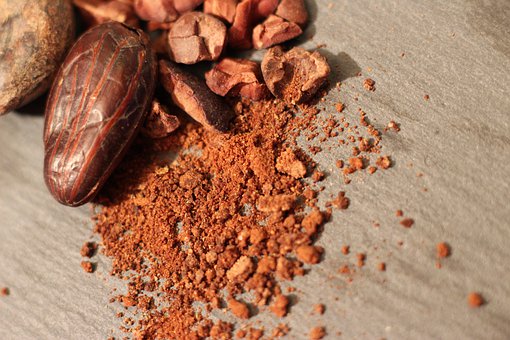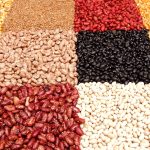When you’re out of cocoa powder and need a substitute, pick one of these easy alternatives to keep the integrity and flavor of your dish. There is a cocoa powder substitute for any recipe, it’s all in finding the right one that meets your needs!
What is cocoa powder?
Cocoa powder is made from the beans of the tropical American cacao tree. The cacao tree was first developed as a crop by several South American cultures and has since appeared in other societies throughout history. Cocoa has been used in food preparations for thousands of years.
Cocoa is produced from cacao beans through fermentation, drying, roasting, and grinding into a paste. The cocoa butter is removed, resulting in a powdery mixture.
Cocoa powder is an unsweetened product made from the beans of the cacao tree. It is in its pure form and has no sweeteners or fats added to it. Cocoa powder has a very bitter taste in its pure form.
It helps give chocolate-based desserts and drinks a rich, deep flavor, color, and fragrance.
You shouldn’t confuse cocoa powder with chocolate powder, because they’re different products.
Cocoa powder is pure and natural, while chocolate powder is processed with other ingredients, such as milk powder and sweeteners.
Health Benefits of Cocoa Powder
Cocoa powder is most commonly associated with chocolate, which most people see as an unhealthy ingredient. However, cocoa powder has health benefits. Studies have shown that cocoa contains more phenolic antioxidants than most foods. Phenolic antioxidants are plant compounds that can help protect your body from disease.
Cocoa has anti-inflammatory, diabetes-preventing, immunity-boosting, and blood pressure-lowering benefits.
As cocoa can help to promote feelings of fullness and reduce appetite, it might be useful as part of a weight-loss plan.
Best Substitutes for Cocoa Powder
Below are some of the best substitutes for cocoa powder.
1. Unsweetened Baking Chocolate
Using unsweetened baking chocolate will give your recipes a strong chocolate flavor. It does not contain any sugar, so it will not make your dish any sweeter. Since unsweetened baking chocolate is ground-up cacao beans without any sweetener, it tastes similar to cocoa powder.
Since it is made from the entire cacao bean, it does include cocoa butter which will require some slight adjustments for baking, but will not greatly impact the flavor or texture. You will need to use less fat in your recipe because it contains cocoa butter.
Powder substitutes are easy to measure, but other substitutes are just as good. You just need to adjust the ratio, such as with baking chocolate. If your recipe calls for 3 tablespoons of cocoa powder, use 2 tablespoons of baking chocolate instead. Baking chocolate is available in bars and has a richer flavor, so you’ll need less of it to get the same chocolate flavor in your recipe. Additionally, in order to get an accurate measurement, you need to melt the baking chocolate before measuring it.
Start by weighing the chocolate, then remove 1 tablespoon of fat from your recipe for each ounce of unsweetened baking chocolate used.
You need to melt the chocolate before using it. The best way to do this is to microwave it in 10-second increments, stirring in between each increment. If you melt chocolate in a pan, sometimes it can get scorched. This method avoids that. Instead of using a double boiler, you can melt the chocolate in a heat-proof bowl placed on top of a pan of boiling water.
For every 3 tablespoons of cocoa powder in your recipe, substitute 1 ounce of unsweetened baking chocolate. Remember to reduce the amount of fat you use when you use this substitute.
2. Cacao Powder
Cacao powder and cocoa powder are made from the same base ingredient, but cocoa and cacao are two different things! To make cacao powder, the whole cacao pod and beans must be ground. Cacao powder may be preferred to cocoa powder by some people in recipes where sweetness isn’t a key flavor. Examples of such recipes include chili and barbecue rubs.
Cacao powder is higher in antioxidants, but it also tastes a lot more bitter than cocoa powder. Although the temperature is low, there is still some processing involved in making cacao.
You may need to add some extra sweetener or a bit of sugar to offset the bitter taste if you want to use it as an alternative to cocoa in your recipes.
If you want to use cocoa powder in your recipe, you will need to use the same amount of cacao powder.
3. Cacao Nibs
Cacao nibs are bits of crushed cacao beans that are sold either raw or roasted. The raw variety is richer in antioxidants.
Cacao nibs are similar to cacao powder in that they add a rich chocolate flavor to dishes, but without the sweetness. In nib form, they also provide a soft, crunchy texture.
You will need to grind the cacao nibs into a powder if you want a texture similar to cocoa powder. You can grind the spices using a food processor or coffee grinder. If you want to use them in a mole-style sauce, you can add them whole and then blend the mixture at the end.
For every 1 tablespoon of cocoa powder in your recipe, you will need to substitute it with 1 tablespoon of ground cacao nibs.
This hazelnut spread made with cocoa powder and sugar can be used as a substitute for regular cocoa powder in some dishes.
Since it is very sweet, you will need to use less sugar in your recipe. It also has about 15g of fat per tablespoon, so you will need to use less fat in the dish until you reach the desired consistency.
You can make your own version of Nutella at home with a blender that can pulverize the nuts.
Here is a recipe to try:
- 8 ounces roasted hazelnuts (skinless)
- 1 cup confectioner’s sugar
- 1/3 cup unsweetened cocoa powder
- 2 tablespoons coconut oil
- 1 teaspoon salt
- 1 teaspoon vanilla
- Process the nuts in a food processor until finely ground, scraping down the sides as necessary.
- Add the confectioner’s sugar and cocoa and continue to process for about 5 minutes, until thoroughly combined.
- Whilst the food processor is running, drizzle in the coconut oil, vanilla, and salt.
- When the mixture is completely smooth, transfer to a clean jar and store in the fridge for up to one month.
For every 3 tablespoons of cocoa powder in your recipe, you will need 4 ounces of Nutella. Remember to reduce the amount of sugar you use if you use this substitute.
5. Carob Powder
The carob powder comes from the carob tree. Although it has a similar appearance to cocoa powder, it doesn’t have the same bitter flavor. However, it can be used as a good replacement if needed!
Carob trees produce a fruit that resembles the color and taste of cocoa beans. The pods that come from the tree are dried and ground into a powder that is used in baking and as a chocolate substitute. The result is a powder that tastes somewhat like cocoa and has a similar appearance.
Carob powder and cocoa powder may look similar, but there are some key flavor differences. Carob powder is much sweeter than cocoa powder, and overall has a less rich flavor. Carob powder is similar to cocoa powder and can be used as a substitution in any recipe.
If you find the carob powder too sweet, use less sugar than the recipe calls for. You can also add more carob powder to intensify the chocolate flavor. Use less sugar in your recipe when substituting carob powder for cocoa powder because carob powder is sweeter.
If you are someone who is sensitive to caffeine, carob powder is a great alternative to cocoa powder in recipes.
In order to replace cocoa powder with an equal amount of carob powder, you will need to use 1 teaspoon of carob powder for every 1 tablespoon of cocoa powder that your recipe calls for.
If you use carob instead of cocoa, your recipe’s flavor will be a little different. To make up for this, you can use less sugar.
6. Chocolate Chips
A chocolate chip bag can be a great substitute if you don’t have a block of unsweetened baking chocolate in the pantry.
In addition to sugar, chocolate chips often contain milk solids and cocoa butter, though this varies depending on the type of chocolate chip.
- Unsweetened chocolate chips are made without any sugar. They will have the closest flavor to cocoa powder
- Semi-sweet chocolate chips have some sugar added. They are still quite bitter though and have a similar rich flavor to cocoa powder.
- Milk chocolate chips have a lot of added sugar and milk or cream. They are quite a bit sweeter than cocoa powder.
The amount of sugar and chocolate chips you use will depend on the sweetness and texture you want.
- 1/4 cup unsweetened cocoa powder
- 1/4 cup sugar
- 1/4 cup milk
- 2 tablespoons butter
- 1 teaspoon vanilla
For each 1/4 cup of chocolate chips you use, follow the ratio above. Then, depending on how sweet your chocolate chips are, you may not need to add any extra sugar.
You may need to leave out some of the fat and milk to adjust the texture.
If a recipe calls for 3 tablespoons of cocoa powder, you can substitute with ½ cup of chocolate chips. Keep in mind that you may need to melt or grind the chocolate chips before adding them to the recipe, depending on what the recipe calls for.
For the best results, add the chocolate chips first, then add the other ingredients slowly, watching the consistency. Taste things along the way.
7. Couverture Chocolate
If you make candy or dip chocolate, you may be familiar with couverture chocolate. Couverture chocolate has a higher percentage of cocoa butter. If you’re out of cocoa powder, you can use melted chocolate as a replacement. It won’t be an exact replacement, as the flavor will be sweeter and the texture will be different, but it’ll still give you a chocolate-y flavor.
Replace cocoa powder with melted couverture chocolate by using 1 less tablespoon.
8. Dark Molasses
This substitute for cocoa powder and can provide a rich, deep flavor that mimics chocolate. For every 2 parts of this, there should be 1 part cocoa powder. Adjust other sweeteners as necessary.
9. Chocolate Protein Powder
You can use chocolate protein powder instead of cocoa powder. It will change the taste and texture of your recipe. You might need to add more liquid or eggs to get the right consistency. This substitution may take some experimenting but you are getting the added protein benefit.
10. Espresso Powder
This ingredient does not provide chocolate flavoring, but it does add a rich flavor and can help to enhance other flavors. Caffeine is also present in this ingredient, so it is best not to use it in recipes that will be consumed by children. Espresso powder is very strong start with a small amount, taste and add as necessary.
Start with a small amount of espresso powder, about ¼ to ½ of what the recipe calls for.
Conclusions
There are plenty of other ingredients that can be used instead of cocoa powder, many of which are just as nutritious and full of flavor. Some of these ingredients can even add their own unique properties to a dish!
Try using different cocoa substitutes in your recipes to see what works best. You may find that one substitution works better than another depending on the dish you’re making!
READ MORE: Dark Chocolate Health Benefits









